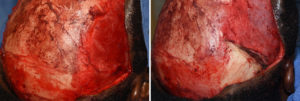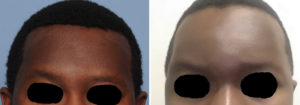Background: The width of the head is controlled by the thickness of tissues above the ears. This consists of skin, fat, muscle and bone. Of these four tissue elements, it is surprising for most people to know that the muscle layer is the thickest of all of them. The posterior belly of the temporal muscle is a lot thicker than is usually appreciated often being 7mm to 9mms in thickness.
The temporal or head width reduction procedure that I have developed uses the removal of full thickness muscle to achieve its effect. While most patients and surgeons want to grind down the bone, it is this soft tissue reduction that has the greatest effect. Removing this portion of the temporalis muscle sees like it would create functional problems with lower jaw opening, but it does not. This is because the bulk of the temporalis muscle is located in the anterior belly and there are other muscle (pterygoid and masseter muscles) that play a role in jaw motion as well.
Temporal reduction is usually done through limited incisions that are hidden as much as possible. This is because most patients that have heads that are perceived as being too wide or convex are men who have close cropped hairstyles or shave their heads. Small temporal or postauricular incisions are usually used. In rare cases where a coronal scalp scar already exists or other procedures are being done that necessitate such a long scalp incision will it be done with such open exposure.
Case Study: This young middle-aged male had a prior history of brow bone reduction and an existing full length coronal scalp scar. He was bothered by the width at the sides of his head and its protruding convex shape.


Highlights:
- A wide side of the head can be reduced by temporal muscle reduction.
- The most significant temporal reduction of muscle can be done through an open scalp incision
- Complete temporal muscle removal usually results in significant head width narrowing.
Dr. Barry Eppley
Indianapolis, Indiana


